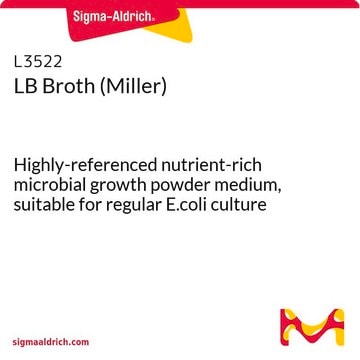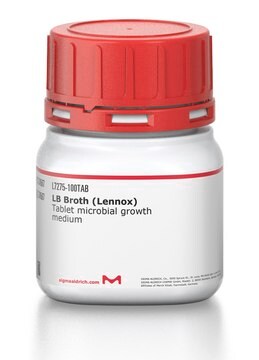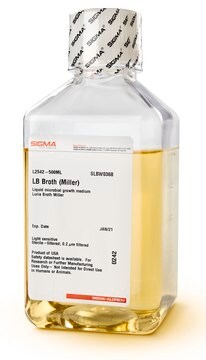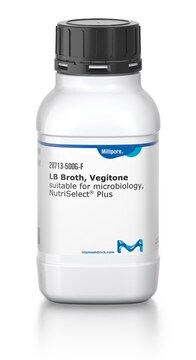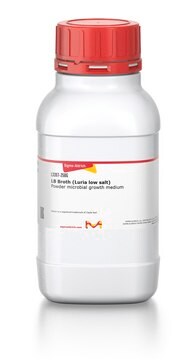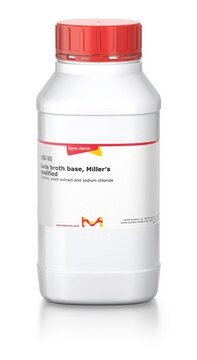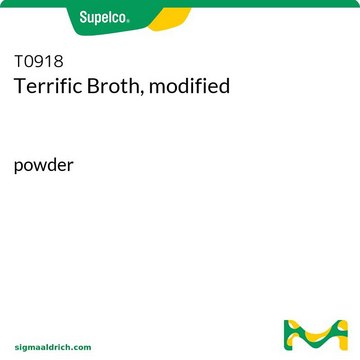L3022
LB Broth (Lennox)
Highly-referenced microbial growth powder medium, low salt, suitable for salt-sensitive E.coli culture.
Synonym(s):
Lennox broth, Lennox broth , Luria Bertani Broth
Sign Into View Organizational & Contract Pricing
All Photos(2)
About This Item
UNSPSC Code:
41106200
NACRES:
NA.85
Recommended Products
grade
for molecular biology
Quality Level
sterility
non-sterile
form
powder
composition
NaCl, 5 g/L
Tryptone, 10 g/L
Yeast Extract, 5 g/L
technique(s)
microbiological culture: suitable
pH
6.8-7.2(2% solution)
application(s)
food and beverages
microbiology
storage temp.
room temp
suitability
nonselective for Escherichia coli
nonselective for coliforms
General description
Lennox LB is a highly-referenced microbial growth medium used for the cultivation of E. coli. This nutrient-rich microbial broth contains peptides, amino acids and carbohydrates in a low-salt formulation.
Application
Luria Broth is used for maintenance and propagation of Escherichia coli. The E. coli grow faster in Luria Broth because the tryptone and yeast supply essential growth factors that the E. coli would otherwise have to synthesize. Luria Broth also contains essential electrolytes for transport and osmotic balance, due to the NaCl component.
It was used for resuspension of T. pyriformis cell fractions in a study of Trimastix fractionation of cellular extracts.
It was used for resuspension of T. pyriformis cell fractions in a study of Trimastix fractionation of cellular extracts.
Suitable for non-selective cultivation of E. coli strains for cloning, DNA plasmid production and production of recombinant proteins. Also suitable for selective cultivation when appropriate antibiotics are added, including those that require low-salt conditions, such as Zeocin®.
Features and Benefits
Lennox LB powder provides:
- Convenient small package to eliminate weighing
- Easy scale-up using larger package sizes
- A budget-friendly alternative to liquid
- Standard formulation
Preparation Note
1. Suspend 20 g in 1 L of distilled water.
2. Autoclave for 15 minutes at 121 °C.
To prepare Lennox L Broth: Add 1 g glucose and proceed with preparation instructions as above.
To prepare the medium of Enquist and Sternberg: Aseptically add 10 ml of sterile 1 M magnesium sulfate after autoclaving.
2. Autoclave for 15 minutes at 121 °C.
To prepare Lennox L Broth: Add 1 g glucose and proceed with preparation instructions as above.
To prepare the medium of Enquist and Sternberg: Aseptically add 10 ml of sterile 1 M magnesium sulfate after autoclaving.
Legal Information
Zeocin is a registered trademark of Cayla Sarl
related product
Product No.
Description
Pricing
replaced by
Product No.
Description
Pricing
Storage Class Code
11 - Combustible Solids
WGK
WGK 3
Flash Point(F)
Not applicable
Flash Point(C)
Not applicable
Personal Protective Equipment
dust mask type N95 (US), Eyeshields, Gloves
Choose from one of the most recent versions:
Already Own This Product?
Find documentation for the products that you have recently purchased in the Document Library.
Customers Also Viewed
Margot Doberva et al.
Frontiers in microbiology, 8, 1152-1152 (2017-07-12)
Quorum sensing (QS) is a density-dependent mechanism allowing bacteria to synchronize their physiological activities, mediated by a wide range of signaling molecules including
J Benavente et al.
International journal of biological macromolecules, 103, 758-763 (2017-05-27)
The preparation of silver nanoparticles (AgNPs) and their incorporation into the structure of a regenerated cellulose membrane by dip coating is presented. Morphological characterization of the AgNPs (average diameter of 20±2nm) was carried out by SEM/TEM, while elastic, electrical and
Cheyann Lee Wetteland et al.
Acta biomaterialia, 35, 341-356 (2016-03-01)
This article reports the quantitative relationship between the concentration of magnesium oxide (MgO) nanoparticles and its distinct biological activities towards mammalian cells and infectious bacteria for the first time. The effects of MgO nanoparticles on the viability of bone marrow
Francisco Dávila et al.
The Journal of experimental biology, 221(Pt 6) (2018-02-16)
Bacteria can damage sperm and thus reduce the reproductive success of both males and females; selection should therefore favour the evolution of antimicrobial protection. Eusocial hymenopterans might be particularly affected by such bacterial infections because of their mating ecology. In
Zuzana Zubáčová et al.
PloS one, 8(3), e55417-e55417 (2013-03-22)
All eukaryotic organisms contain mitochondria or organelles that evolved from the same endosymbiotic event like classical mitochondria. Organisms inhabiting low oxygen environments often contain mitochondrial derivates known as hydrogenosomes, mitosomes or neutrally as mitochondrion-like organelles. The detailed investigation has shown
Our team of scientists has experience in all areas of research including Life Science, Material Science, Chemical Synthesis, Chromatography, Analytical and many others.
Contact Technical Service